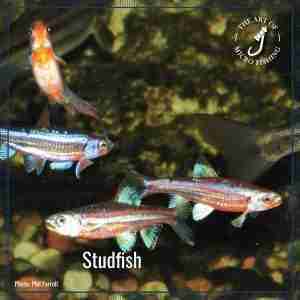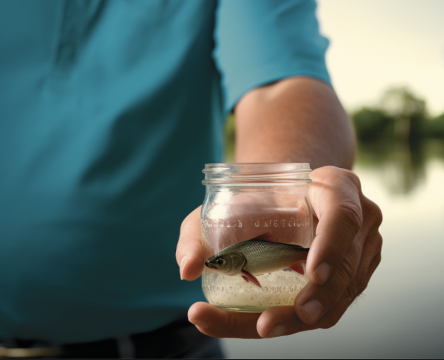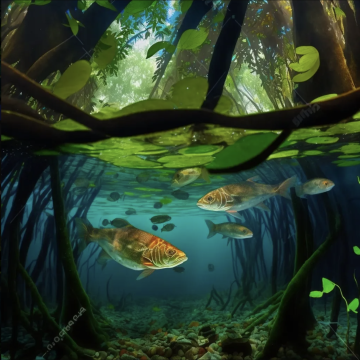Catching and keeping native fish in an aquarium is an exciting activity for new hobbyists and old aquarists alike. It is very much like keeping tropical fish except you are keeping local fish. Minnows like dace, darters, and shiners can make great tank inhabitants. It can open new doors for all experience levels. Nothing will teach you more than getting out and microfishing for the aquarium. It is also a great family activity!
Minnows like Redline Darters and Redbelly Dace can make great tank inhabitants.
 Microfishing is an excellent way to obtain aquarium specimens. Some locations have laws against using a seine net or traps. Netting can destroy natural habitat and displace fish. It can also be stressful having their scales ground about by debris raked through the net. Microfishing allows very specific sight fishing and often the more brave and colorful specimens come out and take the bait.
Microfishing is an excellent way to obtain aquarium specimens. Some locations have laws against using a seine net or traps. Netting can destroy natural habitat and displace fish. It can also be stressful having their scales ground about by debris raked through the net. Microfishing allows very specific sight fishing and often the more brave and colorful specimens come out and take the bait.
Never keep or target endangered species of fish. It’s a good idea to get familiar with microfish species in your area. Field guides are available for easier identification. Peterson Field Guide to Freshwater Fishes is a good field guide for North America. If you can’t identify it release it back unharmed from where it was caught.
Familiarize yourself with your local fish species after buying your fishing license.
It’s a lot of fun to keep native fish in an aquarium! To aquarists living outside of your region, your native fish are their exotics. When we think aquarium fish we most often think of South America, Africa, and Australia. However, there are 33,000 species of fish on Earth and most of them are smaller. Dont forget about saltwater fish and brackish water, there are other fish aside from freshwater fish.
The North American Native Fishes Association has a lot of info on native species of fish for the angler and aquarist.
All aquarium fish started out as wild fish somewhere. Many species have never been successfully kept in captivity though and it’s not always because they can’t. Some fish just can’t be caught easily enough in commercial volume. Others are hard to breed in captivity. Some we just haven’t discovered their needs.
There are a number of native fish that can be kept in captivity, but some are not suitable for a typical community aquarium. A major reason some of these fish may not be suitable is that they require specific environmental conditions or grow too large. For example, keeping a trout requires cold water temperature and a chiller would have to be used. Gar can grow to very large size. Eel species can get large and become escape artists.
Research and be certain you can provide proper conditions.
Some fish eat very specific foods like specific live foods and feeding them would be nearly impossible. Bass, for example, can grow very large. Sunfish like Bluegill can be very aggressive and rule over even your meanest cichlids. Catfish like bullheads can fit other fish their own size in their mouths. Perch are predators and will eat smaller fish. Game fish often have more laws restricting their collection so check out the rules and regulations after you get your fishing license.
Fast flowing river fish can be kept in an aquarium as long as the tank is large enough and the species is suitable for aquarium life. Some types of river fish should have their own tank setup specifically for them. Fast flowing clear rivers often have high oxygen saturation. Fish from these types of water need a lot of water movement and high volume filters and pumps may be necessary. Make sure that conditions can be met before keeping fish for these reasons.
If you want to keep wild caught native fish (or even exotics like goldfish and cichlids can be caught microfishing in some places) for your aquarium you can do so by following some simple steps. You need to keep a healthy habitat for the fish, which includes sufficient water volume and surface area, proper substrate, and a sufficient quantity of proper food.
Small fish species often do better when they are kept in groups.
Normally, small fish less than a few inches grown can be kept comfortably in aquariums. Most small fish do better when they are kept in groups. However, larger fish require a large aquarium to help them be stress free and move about freely. Community tanks will be often happier and healthy with a mixture of smaller fish that inhabit different areas of the aquarium, such as bottom, middle level swimmers, and upper column dwellers.
If you are planning to keep fish in your aquarium, then you should take a look at the different species in your area and make a decision. There are many suitable native fish species for the aquarium such as shiners, dace, and even killifish. The list doesn’t stop there though. There are so many native fish that not all of them have information readily available about their care and habits in captivity.
Some commonly kept North American Native Fish Species caught Microfishing
- Rainbow shiners, Notropis chrosomus
- Fieryblack shiners, Cyprinella pyrrhomelas
- Northern studfish, Fundulus catenatus
- Saffron shiners, Notropis rubricroceus
- Flagfin shiner, Pteronotropis signipinnis
Keeping native species in an aquarium allows you to recreate the natural habitats, known as biotopes, these fish live in. Another very important part of keeping native species is providing natural food sources found in their natural habitats, such as algae, insects, and plant matter. One of the best ways to learn these aspects of keeping native species in a fish tank is to observe them in their natural habitats. See what they do, what they eat, where they hide and when they come out.
Microfishing gear is pretty simple. You will need some monofilament or fluorocarbon fishing line, a pole of some sort, and some hooks. The Art of Microfishing has the size #30 Aldridge #1 hook available that is already tied and ready to use. The hook gap is small, 1.9mm wide, to catch the smallest of fish and reduce injury. Hook and line caught microfish have a high survival rate. A pair of tweezers or hemostats will come in handy removing hooks.
Catching and caring for native fish caught microfishing.
Once specimens are caught on hook and line carefully remove the hook. A five gallon bucket or plastic bags are good for tranpsorting fish safely. When using any container make sure to leave appropriate air space for oxygen otherwise the fish will suffocate and die. Buckets, bins, and tubs could benefit from a battery operated air pump with an airstone for transporting fish.
When filling bags for fish use the cleanest water possible. Muddy water or water with lots of detritus can deplete oxygen levels quickly. Use as little water as possible to comfortably house the fish and ensure they get sufficient oxygen. The surface area is important and you want a lot of water surface touching air in the container so it can absorb oxygen. Keep the fish container temperature stable and out of the sun. Make note of water conditions your quarry is found in if possible by taking water temperature, water pH, and samples of substrate and hardscape. This information will help you set up a better biotope and keep your fish happier.
In order to successfully keep native fish or any fish in the hobby in an aquarium, you have to have a suitable size tank that is cycled properly. A cycled tank means that there are sufficient beneficial bacteria to take ammonia from fish waste and turn it into nitrates and nitrites that are much less harmful. Signs of a crashed or uncycled tank is cloudy milky looking water. Cycling a fish tank usually takes a week to begin taking light bioloads.
Filtration in the aquarium is important for a healthy fish tank.
Proper filtration and patience are necessary to be successful. Don’t completely clean filter media or the beneficial bacteria cycle may crash and kill your fish. Rinse filter pads and media in old tank water instead of tap water. Proper filtration and water movement will help ensure water quality is good and help keep your wild caught natives healthy.
Filtration systems are readily available for about any size gallon tank. There are hang on back type box filters and floor canister filter models. The aquarium trade has fishkeeping gear you need for native wild caught fish. Large fish tend to make more waste and have a higher bioload needing more filtration. More specimens of smaller fish have a lower bioload and the average aquarist will have good luck with keeping the tank clean. Selecting fish with hardiness also makes it easier as a dead specimen unseen can also ruin your cycled tank.
Quarantine every new fish in a hospital tank dedicated to new tankmates.
Fish specimens you catch micro fishing can have diseases or parasites. Columnaris and ich are commonly seen in wild caught fish. Sometimes they are sick and you will not get them healthy again. So you have to take care of them and feed them properly. It is wise to quarantine all new fish for some time. The quarantine period helps the fish to get healthy if they are not and keeps disease and parasites from spreading in your tank.
New fish should be put in a quarantine tank by themselves. A plastic shoe bin with a sponge filter made with tubing and filter floss works great for this. It’s easy to clean and disinfect. There are medicines for the aquarium that kill internal and external parasites. These should be used as a precaution when necessary so that parasites aren’t introduced into the main aquarium. Once fish start eating they should gain weight. If they are eating and not gaining weight they may have internal parasites. Inspect them closely regularly for external parasites. This practice should be done with every freshwater, brackish, or saltwater fish species you intend to keep.
Feeding your wild caught microfishing specimens is a process usually.
Getting your wild caught native fish to eat may take some time. Usually after acclimating to their new environment fish will begin to eat in a day. Sometimes they will eat right away or in hours after being caught. Remove uneaten food as it will spoil and cause poor water conditions.
Wild caught fish will often refuse flake food initially. Live foods like mosquito larvae, brine shrimp, or scuds may need to be obtained. Introduce flake food in small amounts moments before adding in live foods that they will eat. The premise is to get them used to you feeding them. As they do they will have a higher likelihood of trying to eat flake food or pellets. Once they do start eating flake or pellet continue to offer live foods and other types as a balanced diet.
Never return aquarium kept fish back into the environment you caught them. It is possible to introduce aquarium diseases to wild populations. If you no longer want them give them to another hobbyist. Remember that wild caught native fish are native to where you caught them and not all watersheds or sections naturally. Never release exotic fish like cichlids or plecos into the waterways.
Microfishing for aquarium fish can be a very rewarding pastime. There are so many fish suitable for the aquarium. Saltwater and brackish water have a lot of interesting micro sized fish too. There’s no better way to learn about biotopes and natural habitats than microfishing for the fish tank. It’s rewarding and exciting as well as relaxing. Get set up and get out and catch some native fish microfishing for your aquarium.
by Edward Johnson
photo: Phil Farrell




